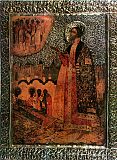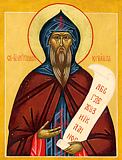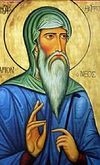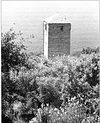

| Previous day | Next day |
| Old Style
February 14
|
Tuesday |
New Style
February 27
|
|
2nd Week of Great Lent.
Tone 5.
Great Lent. |
Monastic rule: xerophagy (bread, uncooked fruits and vegetables).
|
![]() St. Auxentius, monk, of Bithynia (ca. 470).
St. Auxentius, monk, of Bithynia (ca. 470). ![]() St. Cyril, Equal-to-the-Apostles, teacher of the Slavs (869).
St. Cyril, Equal-to-the-Apostles, teacher of the Slavs (869).
St. Maron, hermit of Cyrrhus (ca. 433). St. Abraham, bishop of Charres in Mesopotamia (5th c.). St. Isaac, recluse of the Kiev Caves (ca. 1090). Translation of the relics of Martyrs Prince Michael and his counselor Theodore, of Chernigov (1578).
New Hieromartyr Onesimus (Pylaev), bishop of Tula (1937).
St. Peter, patriarch of Alexandria (380). Hieromartyr Philemon, bishop of Gaza. New Martyr Nicholas of Corinth (1554). New Monk-martyr Damian of Philotheou and Kissavos, at Larissa (1568). New Martyr George the Tailor, of Mytilene, at Constantinople (1693). St. Hilarion the Georgian (the New) of Imereti and Mt. Athos (1864). St. Raphael, bishop of Brooklyn (1915).
Repose of Archimandrite Barsanuphius of Valaam and Morocco (1952), Righteous Barbara (Arkhangelskaya) the Recluse, of Ufa (1966), and Elder Ephraim of Katounakia (1998).
Thoughts for Each Day of the Year
According to the Daily Church Readings from the Word of God
By St. Theophan the Recluse

Tuesday.
And Cain said unto the Lord, My punishment is greater than I can bear (Gen. 4:13). Was it possible to talk like this before the countenance of God, Who is strict of course in righteousness, but is always ready to have mercy upon a sinner who truly repents? Envy obscured sensible thoughts, deliberate transgression hardened his heart, and behold, Cain rudely answers to God Himself: Am I my brother’s keeper? (Gen. 4:9). God wants to soften his stony heart with the hammer of His strict judgement; but Cain does not give in, and locked in his coarseness, he commits himself to the lot which he prepared for himself through his envy and murder. What is amazing is that after this he lived like anyone else: he had children, established a household and maintained earthly relations. Yet the mark of being outcast and of his despair still lay on him. So it is an inner affair, which occurs in the conscience, out of the realization of one’s relation to God, under the influence of burdensome passions, sinful habits, and deeds. Let people heed this now especially! But together with this let people resurrect their belief that there is no sin greater than God’s mercy; however, both time and work are needed to soften the heart. But it is either salvation, or ruin!
Articles
 Venerable Isaac the Recluse of the Kiev Near CavesSaint Isaac was the first person in northern lands to live as a fool for Christ. |









